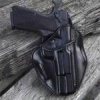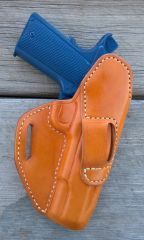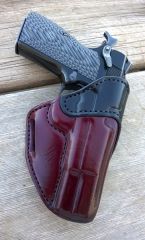-
Posts
174 -
Joined
-
Last visited
Content Type
Profiles
Forums
Events
Blogs
Gallery
Everything posted by BHPshooter
-
I understand the sentiment, but I've found that eventually the settings work themselves loose, and you have to adjust them some more anyway. I marked my tension knobs with a sharpie, which is how I have been able to see the tension knobs walking from time to time. However, the marks help me keep track of where the knobs should be. Nice work, too!
-

First Builds Using The New Machine
BHPshooter replied to cleanview's topic in Gun Holsters, Rifle Slings and Knife Sheathes
I've got no real complaints with S point needles -- they give a nice, clean stitch -- I just really miss that zig-zag pattern that I used to get with a diamond-blade awl when hand stitching. I'd really like to give either LR or VR point needles a try. It's purely a question of aesthetics and personal whimsy. Thanks -- I'd love to know if you can find out. -

First Builds Using The New Machine
BHPshooter replied to cleanview's topic in Gun Holsters, Rifle Slings and Knife Sheathes
JLS, can I ask where you've found needles with different points? I've been looking for LR point needles online with no luck... All I can find are S points. -

Start And Stop On Holster Question
BHPshooter replied to cleanview's topic in Gun Holsters, Rifle Slings and Knife Sheathes
Maybe that's the thing -- I'm using Nylon. I'll have to try Poly. My understanding (flawed though it may be) is that both knobs affect thread tension. I know that had to fiddle with both dials to get things right -- the top knob alone didn't do it. I also marked them with magic marker so that I can make sure exactly how much to change it when switching thread colors. I've noticed that the top knob tends to walk, so it needs to be watched fairly closely. -

Start And Stop On Holster Question
BHPshooter replied to cleanview's topic in Gun Holsters, Rifle Slings and Knife Sheathes
Tension could also be an issue. If it happened on a gradual curve and not a sharper angle, I kinda wonder if it isn't a tension issue. There is very little in the paperwork about all of that, and I had a hell of a time getting it adjusted until I ready a thread in the sewing machine section about recalibrating the tension. Another complication was the fact that I use both white and black thread, and both require different tension settings. You'll get it figured out, it will just take time. If I can do it, anybody can! -

Start And Stop On Holster Question
BHPshooter replied to cleanview's topic in Gun Holsters, Rifle Slings and Knife Sheathes
Cleanview, I have the same machine, and have dealt with some of the same issues, like having trouble getting the stitching on the back of the holster to look good when I'd back-stitch, and missing stitches on turns. I can't say I've completely solved the backstitching issue to my satisfaction, but I have figured out a work-around (which others have mentioned here). When a stitch ends where it began, I just sew over the first 2 or 3 stitches to lock the stitch. I've since changed thread and needle sizes, and I really should try get the reverse function figured out. You're right, though -- it was frustrating. For corners, I watch to make sure that the shuttle hook has caught the top thread before making the turn. I leave the bobbin cover off so that it's easier to see in there. Once you learn how high the needle rises before the shuttle hook catches the top thread, you won't have to stop an look so often... You'll just know. -

Best Blue Guns To Start With?
BHPshooter replied to cleanview's topic in Gun Holsters, Rifle Slings and Knife Sheathes
I think it depends a lot on what your market is. I don't think it's the same for everybody. My most used (not in any order) are the Browning Hi power, full-size 1911, and commander-size 1911. It drops steeply off after that, but use the K-frame S&W mold and Glock 19/23/32 mold a fair amount. I have several that I've only used one time, and I even have one -- a S&W J-frame mold, of all things! -- that I haven't used at all. Ever. My point is, it can be really hard to determine what particular demands you will see. -

Glock Thumb Break Holster
BHPshooter replied to dakotawolf's topic in Gun Holsters, Rifle Slings and Knife Sheathes
It looks to me like you're ready. I have had pieces of Hermann Oak that were better than others, but the worst HO I've seen was still better than anything I've seen at Tandy's. I can say that Hermann Oak made a HUGE difference in the results I have seen in my own work. -

Why Did This Happen?
BHPshooter replied to BHPshooter's topic in Gun Holsters, Rifle Slings and Knife Sheathes
Here is an update to this project, if anyone is interested: http://leatherworker.net/forum/index.php?showtopic=59263 -
I finally got around to remaking the holster that didn't turn out very well (In this thread: http://leatherworker.net/forum/index.php?showtopic=57836 ). Previously, I used Angelus 505 Black for the trim, and Fiebing's Pro Oil Saddle Tan for the body of the holster. This time, I used Angelus Jet Black for the trim, and Angelus Tan for the body. It isn't perfect -- the two-tone thing is still a new process for me, but it did turn out much better this time. It appears that Fiebing's Saddle Tan was the problem, for whatever reason. Question, for those that use Angelus dyes: do you find that pieces dyed black don't accept water very well? I have noticed this with both Jet Black and 505 Black. Pieces I've dyed Tan, Russet Brown, and Cordovan take water just fine.
-

Reinforcing Mouth Of Iwb Holster
BHPshooter replied to asbandr's topic in Gun Holsters, Rifle Slings and Knife Sheathes
I understand where you're coming from, but there are a lot of good reasons to be able to reholster one-handed. You might have the other hand holding a phone to your ear while calling 911, or holding a child. That, in my opinion, is all secondary to the fact that when using your off-hand to open up a collapsed holster, it is difficult (if not impossible) to avoid pointing the gun at your off-hand. Worse yet, some folks like to try to wedge the muzzle into the mouth of the holster and pry/twist/wiggle the gun into place, which frequently results in pointing the muzzle at your innards. It's undeniably true that there is a tendency in the gun world to do things "because the Police/SWAT/SEALS/Arnold Schwarzenneger does it that way." However, that doesn't mean that those practices might apply to normal folks in some situations. -

Reinforcing Mouth Of Iwb Holster
BHPshooter replied to asbandr's topic in Gun Holsters, Rifle Slings and Knife Sheathes
Well, let's be clear -- I'm not saying that it couldn't ever happen, I'm saying that it hasn't happened to me. Just for demonstration's sake, here are some pics. I even cinched my belt an extra notch for these pictures. The holster in the first pic is 2 years old, the holster in the second pic is 1.5 years old, both made with 6/7 Hermann Oak. One-handed reholstering is a requirement for me, and these two meet that requirement. Also, in pic #2, the dog says hello. -

Reinforcing Mouth Of Iwb Holster
BHPshooter replied to asbandr's topic in Gun Holsters, Rifle Slings and Knife Sheathes
Agreed. I'm a big believer in the reinforced mouth. Everything I make these days has a mouth reinforcement. That has not been my experience. I make some IWBs that have the mouthpiece wrap around (like the Sparks VM2), and I make some that don't. I haven't ever had the mouth collapse on any of them... and I carry IWB all day, every day. It's not everybody's thing, I get that. But I'm a believer. -
Luckily, I haven't completely botched one in a while, knock on wood. My recent mistakes have been along the lines of cutting a pattern right-handed instead of left-handed, or for a Commander-sized (4.25") 1911 instead of a 4" 1911. In those cases I completed them later, and was able to sell them without issue. Those are the kinds of mistakes that I can live with. For me, the biggest lesson is not to rush. That's when I make the vast majority of my mistakes.
-
I got a Cowboy CB3200 this summer, and it has increased my productivity by a lot. It has been more than adequate for the things I do (holsters and mag pouches, going to do belts soon). I had absolutely no sewing machine experience prior to this, and it was difficult (and incredibly frustrating) for me to get everything adjusted. I seriously considered just going back to Stohlman-style hand stitching a time or two. Once I figured out some things -- like proper needle size, and the fact that white thread and black thread need different tension settings -- it has been a huge help to me. It is a pretty big purchase, though, so I completely understand why it's hard to decide.
-

Why Did This Happen?
BHPshooter replied to BHPshooter's topic in Gun Holsters, Rifle Slings and Knife Sheathes
I bought it about 2 years ago at a local Tandy shop. I know that it has never been frozen since I bought it (it's stored indoors) but I suppose it isn't impossible that it could have frozen before it was in my possession. -
From the album: Various Holsters
"Highwayman" mid-ride pancake for CZ-75 -
From the album: Various Holsters
-
From the album: Various Holsters
-
From the album: Various Holsters
-
From the album: Various Holsters
-
From the album: Various Holsters
-
From the album: Various Holsters
-
From the album: Various Holsters
















